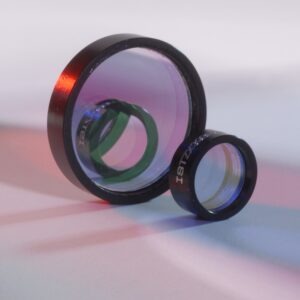Raman spectroscopy is an analytical method based on the detection of scattered light from a sample. Only a small fraction of light that is scattered is suitable for Raman spectroscopy; around 1 in 10 million incident photons induce a Raman scattered photon.
Generating enough scattered photons for Raman spectroscopy purposes requires a high intensity light source which consequently leads to a very high intensity ratio between the light source and the Raman scattered light. One of the most critical points in Raman spectroscopy is therefore the separation of strong Rayleigh scattered light from the weak scattering.
Understanding the Optics of Raman Spectroscopy
Today, lasers are the means of choice for Raman spectroscopy. Special laser line filters transmit light within a narrow bandwidth at high transmittance and deep blocking outside the pass band regime. This filter type is critical as it prevents light outside the filter passband region from reaching the sample. The laser line filter also limits the bandwidth of the laser, in case of a spectrally broad laser emission. For Raman spectroscopy it is crucial that the light source used has a defined spectral width and spectral position relative to any further Raman edge filters in the Raman spectroscopy setup.
Selecting the Right Filters
 There are different filter types in Raman spectroscopy that fulfil the critical purpose of separating source light from the Raman scattered signal. And there is one characteristic feature in Raman scattering that is important for the selection of the appropriate filter type: Raman scattering can occur at lower and at higher wavelengths relative to the laser. That means that scattered photons either gain energy in the scattering process or lose energy. Consequently, the Raman scattering is either blue or red shifted in the wavelength spectrum (anti-Stokes and Stokes scattering respectively).
There are different filter types in Raman spectroscopy that fulfil the critical purpose of separating source light from the Raman scattered signal. And there is one characteristic feature in Raman scattering that is important for the selection of the appropriate filter type: Raman scattering can occur at lower and at higher wavelengths relative to the laser. That means that scattered photons either gain energy in the scattering process or lose energy. Consequently, the Raman scattering is either blue or red shifted in the wavelength spectrum (anti-Stokes and Stokes scattering respectively).
For the critical spectral separation and detection of Raman scattering at both longer and shorter wavelength simultaneously, Raman notch filters are a suitable choice. Notch filters block a narrow wavelength range in between the passband regions. They block the laser line and allow high transmittance of scattered light at both the shorter and longer wavelengths for Raman spectroscopy analysis.
If the detection of Raman photons is limited to Stokes scattering at longer wavelengths than the light source, Raman edge filters (longpass) and dichroic long pass filters are applicable. These types of filters isolate the Raman signal band at a specific edge wavelength. Further, dichroic filters direct source laser light towards the sample while scattered Raman signal from the other direction passes the filter and hits the detector. Raman edge filters are also available as short pass filters to selectively allow anti-Stokes Raman spectroscopy at short wavelengths.
Looking for Raman Spectroscopy Filters?
At Iridian we offer all critical filter types for your Raman spectroscopy needs. You will find a selection of standard wavelength Raman laser line filters, Raman notch filters, Raman edge filters and dichroic long pass filters. In addition to that, custom designs for all filters are available for your individual requirements in your Raman spectroscopy application.
